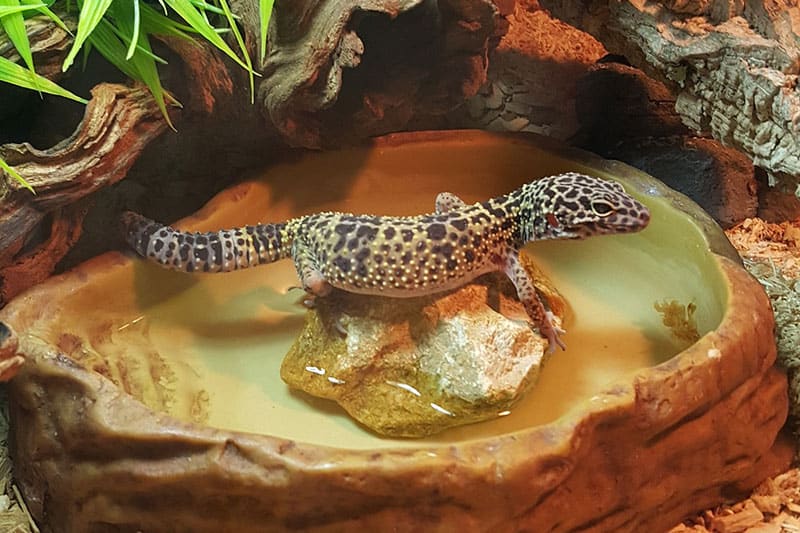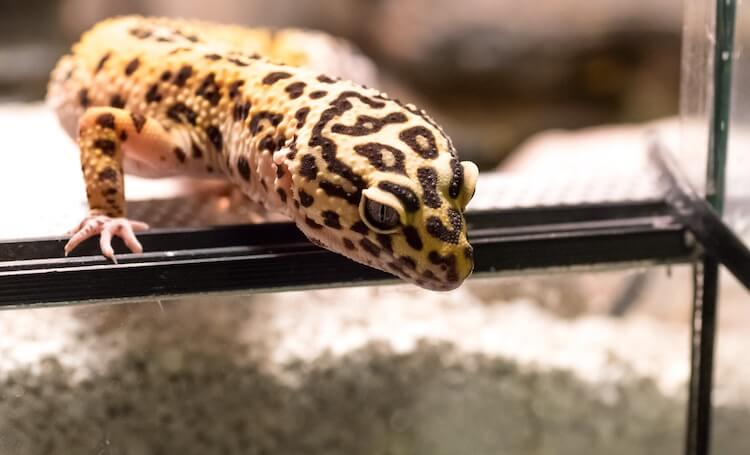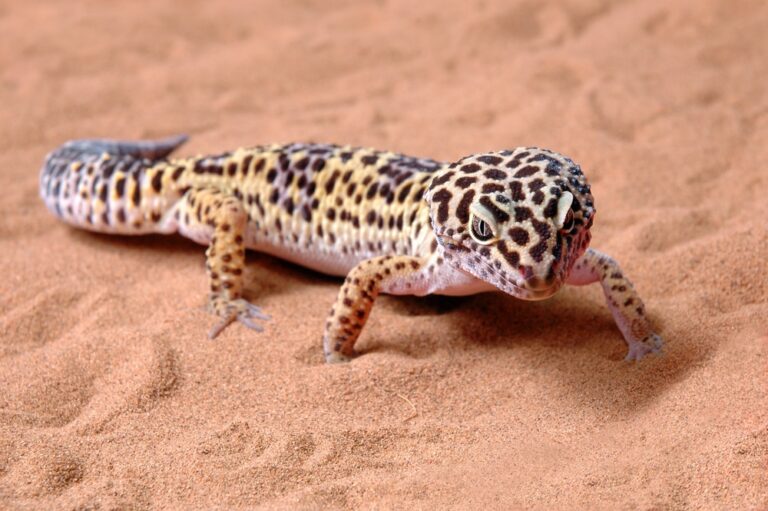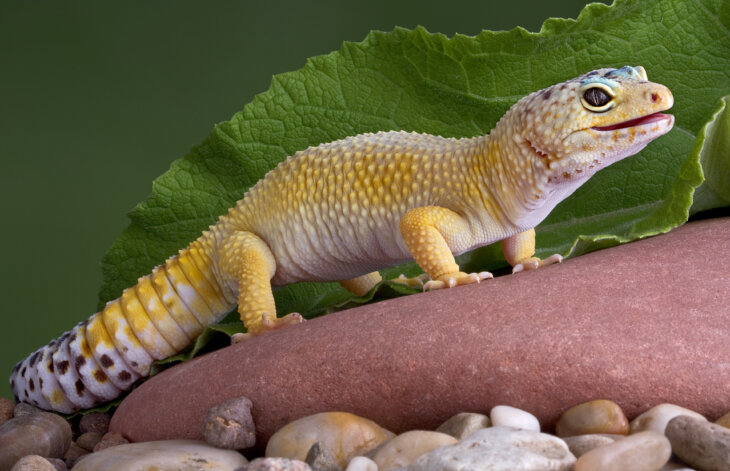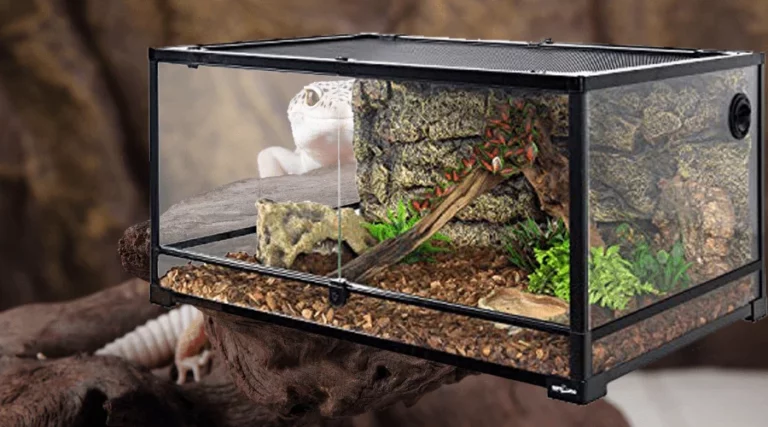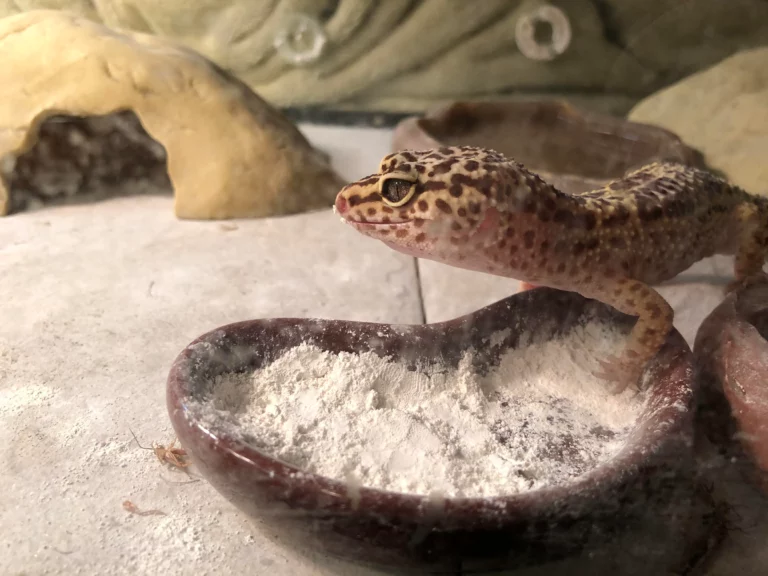How To Clean Leopard Gecko Tank? A Complete Guide
As I peered into the glass enclosure, I couldn’t help but notice the layers of dust and grime that had accumulated on the walls, rocks, and even the faux desert plants. My beloved leopard gecko, a creature of elegance and charm, deserved better than this.
However, It was time to embark on a mission to clean the leopard gecko tank and provide a healthier, happier habitat for my scaly friend. Join me on this journey as I share the steps and tips for giving your leopard gecko’s enclosure the thorough cleaning it deserves.
Here it is:
- Take out food bowls, hides, and decorations.
- Remove waste from the substrate, and change it every 3-4 months.
- Wash tiles with soapy water or steam clean. Clean reptile carpets with soap, rinse and hang to dry. Keep a spare carpet.
- Rinse thoroughly after using chemicals.
- Clean accessories and hides with antibacterial soap, rinse, and dry.
- Sterilize porous items by baking or boiling.
- Clean food bowls, replace water, and remove waste daily.
- Use hydrogen peroxide or vinegar on glass doors weekly. Dry before returning the gecko.
- Ensure accessories are odor-free and completely dry before returning them.
Let’s roll together to gather more information.
The Significance of Cleaning a Leopard Gecko Tank
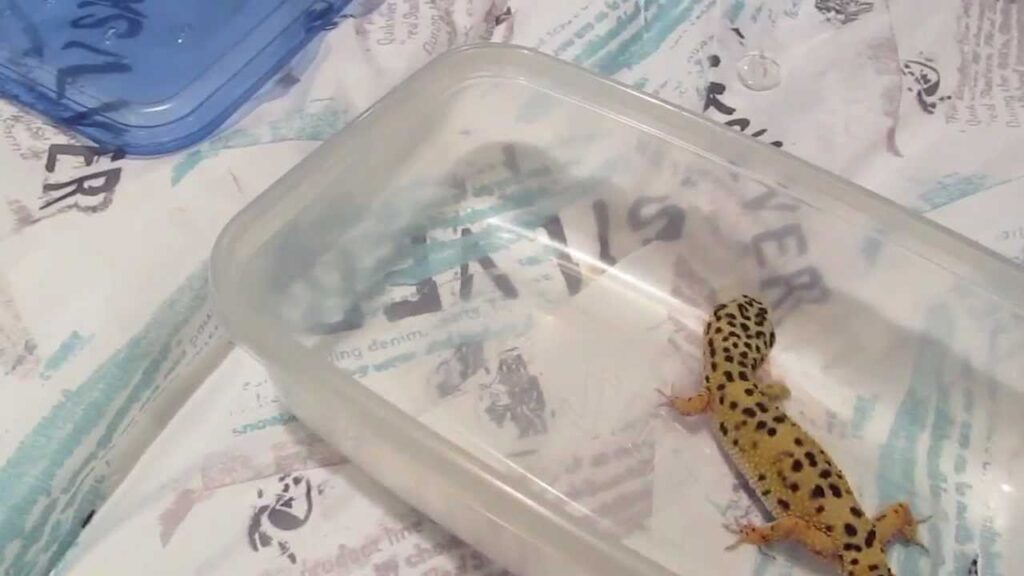
Maintaining the health, vitality, and well-being of your beloved pet is intrinsically tied to the upkeep of a clean environment. Just as essential as providing proper nutrition, regular tank cleaning is an indispensable aspect of leopard gecko care.
Also, establishing a consistent cleaning schedule and diligently adhering to it is a fundamental practice. This routine not only safeguards your reptilian companion from the menace of reptile mites but also plays a pivotal role in ensuring your own well-being, especially if you frequently handle and interact with your pet.
An untidy and unhygienic enclosure can cause profound discomfort to your gecko, impeding its overall comfort and contentment. Thus, the cleanliness of the tank is an integral component in fostering a thriving and harmonious coexistence between you and your buddy.
Leopard Gecko Substrate Options and Maintenance
Tiles or Shelf Liner: Using ceramic tiles or a non-sticky shelf liner as the main floor is the simplest option. They’re easy to clean and budget-friendly. You won’t need to change them often, just keep them clean.
Dig Zone: Create a play area with a low-walled plastic container filled with loose substrates, like sand. Change this loose substrate every four to six months, depending on whether you have live plants (six months) or not (four months).
Bioactive Substrate: This is a natural mix that mimics their habitat. If you have live plants, change them every six months. Without live plants, do it every four months.
Reptile Carpet: Be cautious with reptile carpets. They should be high-quality to avoid loose fibers that can hurt your gecko. Clean the carpet weekly with soap and replace it every six months or earlier if you notice it getting damaged.
Selecting the Ideal Cleaning Solution for Leopard Gecko Tanks
When it comes to choosing the right cleaning solution for your leopard gecko’s habitat, there are several options available, each with its own merits. Conducting thorough research reveals a range of cleaning solutions favored by experienced leopard gecko owners, each catering to specific cleaning needs.
Commercial Grade Reptile Cleaning Solutions: Undoubtedly, the top choice for maintaining a clean and pathogen-free gecko enclosure. Consider the F10SC Veterinary Disinfectant for overall cage, décor, accessories, and hide cleaning. For spot cleaning, the Flukers Super Scrub Brush with Organic Reptile Habitat Cleaner offers a reliable option.
Commercially Available 3% Hydrogen Peroxide: Recognized by the CDC as an effective disinfectant, 3% hydrogen peroxide can be safely used without dilution or additional chemicals. Ensure thorough rinsing to prevent your gecko from encountering any residue, which might cause irritation.
Diluted Vinegar Solution: While not marketed as a disinfectant, vinegar is capable of addressing bacteria like salmonella and E. coli in gecko cages. It serves as a viable cleaning solution to maintain hygiene.
Antibacterial Liquid Soap: Opt for phosphate-free antibacterial dish soap if you choose this route. Be cautious, as the presence of phosphate can result in lingering fumes that may affect your gecko. However, we recommend combining regular dish soap with a reptile disinfectant for a safer alternative.
Diluted Bleach Solution: Although potent at disinfection, diluted bleach is not advised for gecko cage cleaning due to its distinct odor, which can be unpleasant for your pet. Furthermore, mixing bleach with other cleaning agents like dish soap can generate harmful fumes that pose risks to both you and your gecko.
A Comprehensive Guide to Cleaning a Leopard Gecko Habitat
Ensuring a clean and healthy habitat for your leopard gecko is essential for its well-being. Here’s a detailed, step-by-step approach for both routine and deep cleaning:
Gathering Supplies: Begin by gathering your cleaning supplies. The extent of cleaning will dictate the materials needed.
Temporary Relocation: First, Wear gloves. Then carefully remove it from the enclosure and place it in a Kritter Keeper or a plastic container lined with paper towels. If using any cleaning chemicals, take your geck to a separate, well-ventilated room, as these sensitive creatures can be affected by chemical fumes.
Shutdown of Devices: Unplug any heating or electrical devices within the enclosure.
Accessory Removal: Take out all accessories such as food bowls, hides, and any decorations, placing them in a bucket. If you have reptile carpet or tiles, remove them as well.
Steam Cleaning or Reptile Safe Spray: Utilize a steam cleaner to thoroughly clean the entire enclosure, including the glass and flooring. Rinse with water and wipe with paper towels. Steam cleaning is suitable for both quick weekly cleanings and more extensive deep cleanings. Alternatively, you can use a commercially available reptile-safe habitat spray.
Substrate Maintenance: If your habitat includes a loose substrate, employ a scoop to remove any feces or deceased insects. Check corners for waste and debris. Add fresh substrate if necessary, replacing the loose substrate entirely every 3-4 months.
Detail Cleaning: Use Q-tips or small tools to reach and clean the corners and crevices of the enclosure.
Tile Cleaning: If you utilize tiles, remove them from the tank and wash them with hot soapy water. Alternatively, you can use a steam cleaner for this purpose.
Carpet Care: For reptile carpets, remove and wash them with a gentle antibacterial liquid soap, rinse thoroughly, and hang them to dry. While drying, place a spare carpet in the tank.
Chemical Cleaning: If a steam cleaner is unavailable, create a solution of bleach or a commercial cleaning spray for wiping down the glass and flooring. Hydrogen peroxide or vinegar can also be used. Ensure thorough rinsing and ventilation to eliminate any residual odor before reintroducing your gecko.
Accessory Cleaning: Clean all accessories and hides by either steam cleaning or soaking them in a bucket with antibacterial soap. Rinse well and allow them to dry.
Porous Materials: If you have accessories made from porous materials like pebbles, wood branches, or ropes, sterilize them by baking in the oven at 250°F (121°C) for 30 minutes or boiling in hot water for 20-30 minutes.
Hand Hygiene: Wash your hands after handling accessories to prevent transferring germs back to the cleaned items.
Daily Maintenance: For daily upkeep, wash food bowls with hot soapy water, replace water, and remove uneaten crickets and waste.
Weekly Glass Cleaning: Use hydrogen peroxide or vinegar to clean glass doors. Spray, allow it to sit for 5-10 minutes, then wipe with a cloth soaked in water. Finish by drying with paper towels.
Accessories Return: Before returning any cleaned accessories to the tank, ensure they are odor-free and completely dry.
Effective Leopard Gecko Tank Maintenance Routine
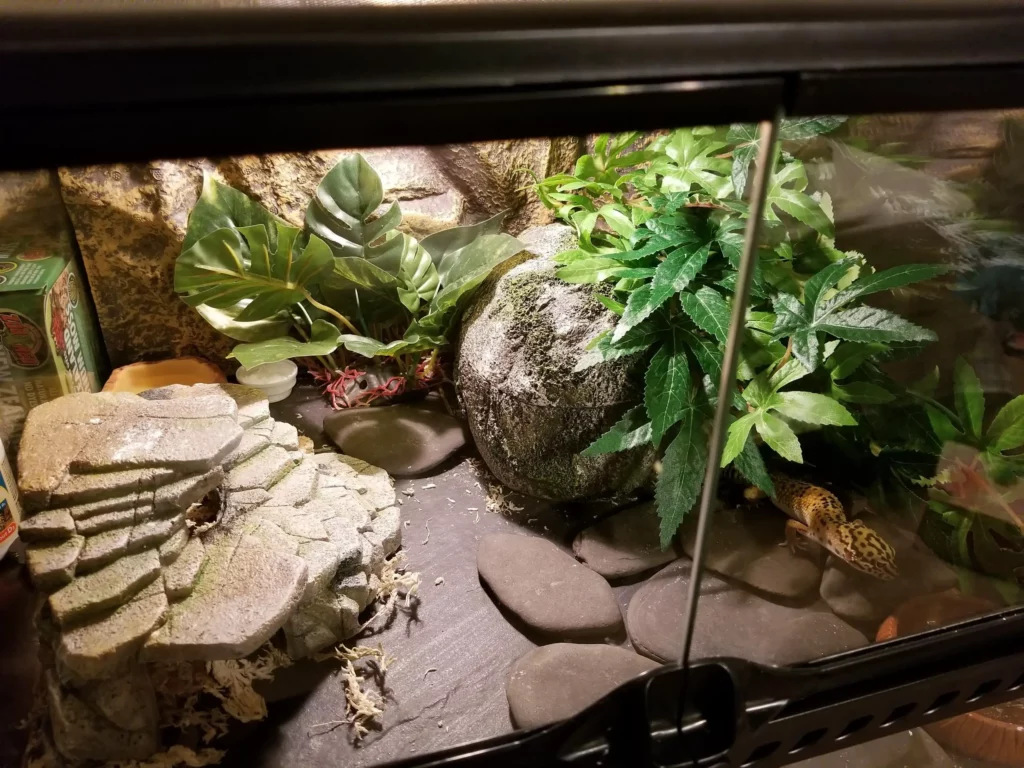
Ensuring a clean and healthy living space for pets requires a well-structured maintenance routine. Here’s a comprehensive guide to maintaining your gecko’s tank:
Daily Tasks:
- Replace the water in the dish daily to provide your gecko with fresh, clean water.
- Promptly remove any feces or waste as soon as you spot them, ensuring a sanitary environment for your pet.
- If you’re using paper towel substrate, consider changing it 1-2 times a week, maintaining cleanliness and hygiene. If you have a carpet, wash it with soap weekly for cleanliness. For loose substrate (excluding bioactive setups), scoop waste daily.
- Clean tiles on a weekly basis to keep them spotless and appealing.
- Wash food and water bowls with soap once a week to prevent bacteria buildup.
- Conduct a weekly search for unseen waste and hidden insects beneath the substrate and around the tank.
- Clean the glass doors weekly to maintain transparency and aesthetics.
Monthly Tasks:
Deep Cleaning: Once a month, engage in a thorough cleaning regimen. Remove all accessories, take apart the cage, and wash the interior meticulously. Disinfect the cage interior and wipe both the inside and outside surfaces. Wash and disinfect all accessories to prevent bacterial buildup.
Longer-Term Tasks:
Substrate Replacement: Depending on your setup, change loose substrate every 2-4 months to prevent the accumulation of waste and maintain a healthy environment.
FAQs
How often do I need to clean my leopard gecko tank?
Leopard gecko tanks should undergo routine cleaning, including daily waste removal, weekly substrate maintenance, and monthly deep cleaning.
How should I clean my leopard gecko tank?
To clean a leopard gecko tank, follow a systematic routine that involves daily waste removal, weekly substrate care, monthly deep cleaning, and safe cleaning solutions.
What can I use to clean my leopard gecko enclosure?
You can use cleaning solutions like reptile-safe sprays, diluted vinegar, or 3% hydrogen peroxide for enclosure cleaning. Ensure thorough rinsing and ventilation when using chemicals.
How do you clean poop out of a leopard gecko tank?
Promptly remove leopard gecko waste with a scooper or tissue daily. For thorough cleaning, follow a monthly deep cleaning routine to eliminate any hidden waste.
Can I soak my gecko in water?
Yes, occasional lukewarm water soaks can benefit your gecko, aiding in shedding or rehydration. However, avoid making it a frequent practice.
Do leopard geckos need to be wet?
No, Leopard geckos do not require frequent wetting. They naturally obtain moisture from their diet and should not be subjected to prolonged humidity to prevent health issues.
Final Words
In conclusion, maintaining a clean and healthy leopard gecko tank is paramount to ensuring the well-being of our scaly companions. By diligently following the cleaning and maintenance routine outlined earlier, I can provide my leopard gecko with a safe and hygienic environment.
Daily tasks such as changing the water, removing waste, and checking for any hidden debris ensure that my gecko’s habitat remains pristine on a day-to-day basis. These small yet regular actions significantly contribute to my pet’s overall health and comfort.
On a monthly basis, embarking on a thorough deep cleaning session helps me address any accumulated grime, ensuring that the tank remains a welcoming and disease-free home for my gecko.
Furthermore, recognizing the importance of substrate maintenance, I am committed to changing loose substrates as needed to prevent waste buildup.
By adhering to this comprehensive cleaning regimen, I am not only fulfilling my responsibilities as a pet owner but also forging a strong bond with my leopard gecko, creating an environment where it can thrive and flourish.

